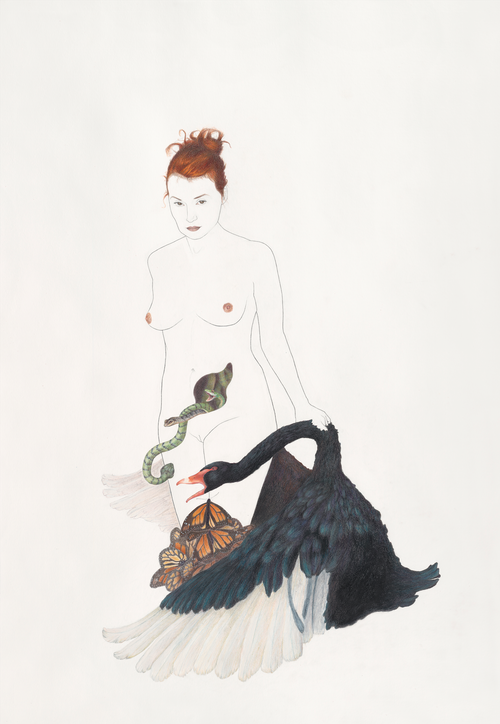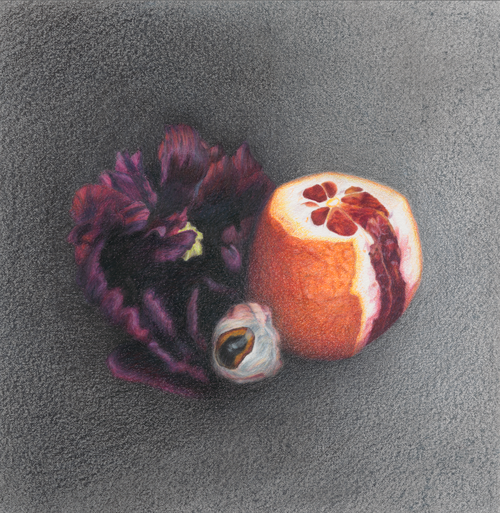
Legacy, 2014. 44″ x 30″. Colored Pencil on Stonehenge. Courtesy Packer Schopf Gallery
Kathleen Rooney on Lauren Levato Coyne’s Wolf Peach
Fittingly for the shift from the flowering of summer to the withering of autumn, on September 5, the Packer Schopf Gallery in Chicago opened their fall season with a set of three simultaneous solo shows designed to address the issues of death. It included the cyanotypes of Teresa James, meditating on religion and faith, and the mixed media and painted gloves and dresses of Ellen Greene, concentrating on murder ballads. And perhaps most memorably, it included Wolf Peach, a collection of intricate yet spare drawings by Lauren Levato Coyne, lush in color and rich in deliberation on the intergenerational effects of poisons, both natural and unnatural, upon the mental and physical health of individuals and populations. Levato Coyne’s realistic and representational yet impossible and dream-like images invite the viewer to contemplate the visibility of visual art and the invisibility of toxins and their impacts on the body.
The show’s title itself, Wolf Peach—a translation of lycopersicum, the species name for the tomato plant—speaks to Levato Coyne’s concerns with hybrids and blending, as well as her ever-present elicitation of the tension of opposites. Each of the ten images, ranging in size from the 10 x 10-inch “Blistering Agent” (evoking the manmade weaponized chemical Agent Orange, originally believed to be a defoliant with no deleterious effects on humans) to the 44 x 30-inch “Legacy” (depicting a partly nude woman with green snakes in her abdomen instead of viscera) calls to mind the idea of the pharmakon—the drug that can be both a poison and a remedy, or a cause of illness that can also be its cure. If one considers the words Wolf Peach separately, one might think: a wolf is beautiful and wild, and can be the sign of a healthy ecosystem, but it might also tear you to shreds were you to encounter it in that ecosystem. And one might also think: a peach is a delicious and ostensibly healthy snack, but has a cyanide pit at its center and might be covered in pesticides that you can neither see nor taste. In fact, “lycopersicum” comes from the allegation in Central European folklore that witches and wizards used deadly nightshade to transform themselves into werewolves; when the tomato was introduced to Europe, its similar appearance to its close cousin nightshade caused it to be feared as a poison and given a name that alluded to its falsely magical properties—another instance of vision being an unreliable detector of toxicity.

Blistering Agent, 2014. 10″ x 10″. Colored Pencil on Bristol. Courtesy Packer Schopf Gallery
Levato Coyne builds tension not...
You have reached your article limit
Sign up for a digital subscription and continue reading all new issues, plus our entire archives, for just $1.50/month.
Already a subscriber? Sign in




